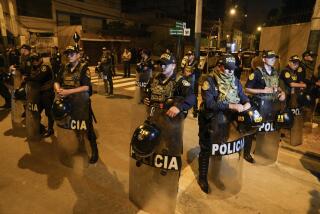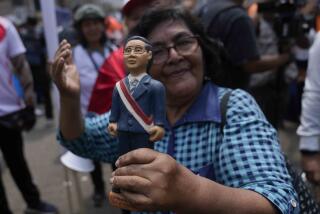Something’s fishy in Peru
Are food and drink -- their need, their taste, their origin -- hot political matters?
Yes they are, at least here in Peru, where the politics of catastrophe have collided with South American squabbles twice recently.
The first fracas was the canned tuna affair. Tins of not-too-tasty-looking tuna were briefly but freely distributed to victims of the Aug. 15 earthquake along Peru’s southern coast. The labels featured side-by-side photos of two macho politicians (plus a few rather silly anti-government slogans). One was Hugo Chavez, the president of Venezuela, a coarse military man whose tantrums and loquacity throw us back to the times when Latin American military dictators were as preposterous as they were populist (and, indeed, dangerously popular). The other was Ollanta Humala, the leftist former army colonel who, by a nose, lost Peru’s presidential race a year ago to Alan Garcia.
Now then, why share billing on a tuna can? Chavez is pushing a nasty strain of trade-pact politics by way of an outfit called ALBA (which means “dawn” but is an acronym for Bolivarian Alliance for the Americas). ALBA offices are sprouting like mushrooms in deprived areas across South America, giving away money and making impossible promises. But Chavez needs friends to expand his Bolivarian fantasy, and in Peru, his pal is Humala.
Many believe -- this writer included -- that Chavez financed Humala’s failed political campaign, just as he financed (who could doubt it?) the infamous tuna. The tuna was quickly taken off the food lines, and the scandal died. But there is no death in sight to the alliance between the ornery president of Venezuela and the no-less-ornery would-be president, Humala. That bond will surely give Peru another surprise or two before Chavez’s money and power run out.
But the crown of preposterous surprises on the eatable-drinkable earthquake front goes to Rafael Rey.
A few days ago, Rey, Peru’s well-mannered minister of production, very proudly introduced to the media a new brand of pisco, Peru’s national liquor. It was named 7.9 Pisco, and the whole vintage was meant to be given as presents to foreign workers and volunteers who are helping in the earthquake recovery.
So what’s the big deal here? Well, it so happens that 7.9 is the Richter-scale magnitude of the earthquake, and the town closest to its epicenter was Pisco, the very navel of the coastal region where grapes are grown and distilled into Peru’s delicious, clear brandy. That beautiful, traditional town is now almost destroyed. The 7.9 quake caused more than 500 deaths and left uncounted numbers injured and homeless. Giving out souvenir bottles of 7.9 Pisco to foreign rescue workers is as bad an idea as giving out 9/11 cheesecake to ground-zero volunteers.
So why did the minister of production do this awful, tasteless thing? To help push the claim that Peru is the geographic birthplace of pisco. Chile also makes this claim, hoping against hope that the world will forget that pisco originated centuries ago in the town of Pisco. To lend credence to the assertion, Chile went so far as to rename one of its grape-growing villages “Pisco-Elqui” in the 1930s.
What’s at stake here is the official international “denomination of origin.” If Peru wins the claim, Chile’s rather watery grape liquor -- Chilean grapes are excellent for wine only -- would have to be marketed as “grape spirits” or “Chilean brandy.” This in turn would much reduce Chile’s share of exports. Which is why Peru’s minister of production suddenly showed up for a photo opportunity, 7.9 bottle in hand.
Now pisco makers are hurriedly renaming the product they will hand out to the international volunteers who are helping rebuild Pisco. And nobody is eating the politically tainted tuna anymore -- though Chavez this week accused the CIA of masterminding the fishy plot to discredit him. And the moral of the story is that this recent mix of food, drink and politics hasn’t gone down well here in Peru.
Alonso Alegría is a Peruvian playwright and theater director. He also contributes a weekly column to Peru 21, a daily newspaper in Lima.
More to Read
A cure for the common opinion
Get thought-provoking perspectives with our weekly newsletter.
You may occasionally receive promotional content from the Los Angeles Times.






